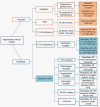Angioedema without wheals: a clinical update
- PMID: 33593719
- PMCID: PMC8909242
- DOI: 10.5152/balkanmedj.2021.20060
Angioedema without wheals: a clinical update
Abstract
Angioedema without wheals (urticaria) represents a heterogeneous group of clinically indistinguishable diseases of hereditary or acquired etiology. Hereditary angioedema is a rare inherited condition leading to recurrent, sometimes life-threatening angioedema attacks in subcutaneous tissues and gastrointestinal and oropharyngeal mucosa dating back to childhood or adolescence. Most of these patients have mutations in the SERPING1 gene, causing either low C1 inhibitor production (hereditary angioedema with C1 inhibitor deficiency type I) or the production of dysfunctional C1 inhibitor (hereditary angioedema with C1 inhibitor deficiency type II). Hereditary angioedema with normal C1 inhibitor has been defined later. Although C1 inhibitor concentration and function are in the normal range, it leads to typical hereditary angioedema symptoms owing to mutations in FXII, PLG, ANGPT1, KNG1, and MYOF genes. Patients who exhibit none of these genetic mutations despite having a similar clinical presentation are classified as having unknown hereditary angioedema. Fewer than 1 in 10 patients with C1 inhibitor deficiency have acquired angioedema with C1 inhibitor deficiency. The clinical presentation is very similar to that of hereditary angioedema, making it difficult to distinguish these 2 conditions clinically. Unlike hereditary angioedema, there are no genetic mutations, and family history and symptoms tend to appear later in life. Acquired angioedema with C1 inhibitor deficiency is commonly associated with lymphoproliferative and autoimmune diseases. Angioedema attacks might start 1 year before the underlying disease in acquired angioedema with C1 inhibitor deficiency. Approximately half of the patients admitted to the hospital for acute angioedema are patients receiving angiotensin-converting enzyme (ACE) inhibitor therapy. Angioedema typically occurs on the lips, tongue, mouth, pharynx, and subglottic regions. Patients may require hospitalization and intensive care monitoring owing to airway involvement. Idiopathic histaminergic acquired angioedema may be diagnosed only when any possible causes of histaminergic angioedema are excluded (foods, drugs, animal dander, aeroallergens, insect stings, latex, and others), and the symptoms respond well to antihistamine treatment. Idiopathic nonhistaminergic acquired angioedema should be considered when all other types of recurrent angioedema have been ruled out and patients do not respond to high-dose antihistamines. The lack of a standard biochemical laboratory test for patients with idiopathic histaminergic acquired angioedema, idiopathic nonhistaminergic acquired angioedema, angiotensin-converting enzyme inhibitor-induced acquired angioedema, and hereditary angioedema with normal C1 inhibitor makes the diagnosis more challenging. Future efforts should focus on increasing awareness of all the rare types of angioedema among physicians and developing more straightforward and more accessible diagnostic methods.
Conflict of interest statement
Figures

Similar articles
-
Angioedema without urticaria: Diagnosis and management.Allergy Asthma Proc. 2025 May 1;46(3):185-191. doi: 10.2500/aap.2025.46.250013. Allergy Asthma Proc. 2025. PMID: 40380367 Review.
-
Presentation, diagnosis and treatment of angioedema without wheals: a retrospective analysis of a cohort of 1058 patients.J Intern Med. 2015 May;277(5):585-93. doi: 10.1111/joim.12304. Epub 2014 Sep 27. J Intern Med. 2015. PMID: 25196353
-
Novelties in the Diagnosis and Treatment of Angioedema.J Investig Allergol Clin Immunol. 2016;26(4):212-21; quiz two pages after page 221. doi: 10.18176/jiaci.0087. J Investig Allergol Clin Immunol. 2016. PMID: 27470642 Review.
-
"Nuts and Bolts" of Laboratory Evaluation of Angioedema.Clin Rev Allergy Immunol. 2016 Oct;51(2):140-51. doi: 10.1007/s12016-016-8539-6. Clin Rev Allergy Immunol. 2016. PMID: 27142368 Review.
-
Angioedema Without Wheals: Challenges in Laboratorial Diagnosis.Front Immunol. 2021 Dec 8;12:785736. doi: 10.3389/fimmu.2021.785736. eCollection 2021. Front Immunol. 2021. PMID: 34956216 Free PMC article. Review.
Cited by
-
Pseudo-Allergies in the Emergency Department: A Common Misdiagnosis of Hypersensitivity Type 1 Allergic Reaction.Cureus. 2023 Oct 5;15(10):e46536. doi: 10.7759/cureus.46536. eCollection 2023 Oct. Cureus. 2023. PMID: 37927771 Free PMC article. Review.
-
Current challenges and future opportunities in patient-focused management of hereditary angioedema: A narrative review.Clin Transl Allergy. 2023 May;13(5):e12243. doi: 10.1002/clt2.12243. Clin Transl Allergy. 2023. PMID: 37227422 Free PMC article. Review.
-
A Comprehensive Review of Bradykinin-Induced Angioedema Versus Histamine-Induced Angioedema in the Emergency Department.Cureus. 2022 Nov 30;14(11):e32075. doi: 10.7759/cureus.32075. eCollection 2022 Nov. Cureus. 2022. PMID: 36600855 Free PMC article. Review.
-
Clinical validity of dried blood spot assay for the measurement of functional C1 inhibitor in angioedema due to C1 inhibitor deficiency.J Allergy Clin Immunol Glob. 2025 Jan 7;4(2):100401. doi: 10.1016/j.jacig.2025.100401. eCollection 2025 May. J Allergy Clin Immunol Glob. 2025. PMID: 39944300 Free PMC article.
-
Decreased adhesion to endothelium leads to elevated neutrophil granulocyte count in hereditary angioedema patients.Sci Rep. 2023 Aug 17;13(1):13366. doi: 10.1038/s41598-023-40442-9. Sci Rep. 2023. PMID: 37591965 Free PMC article.
References
-
- Saini SS. In: Urticaria and angioedema in Middleton’s Allergy Principles and Practice. 8th edition. Adkinson NF, et al., editors. Philadelphia: 2014. pp. 575–587. - DOI
MeSH terms
Substances
Supplementary concepts
LinkOut - more resources
Full Text Sources
Other Literature Sources
Medical
Miscellaneous
